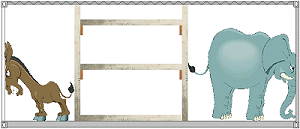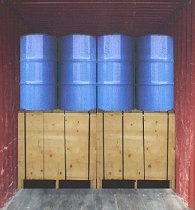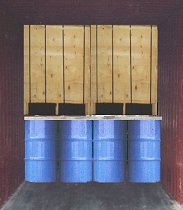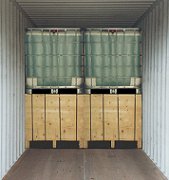 |
Do not load incompatible goods together! |
 |
Stowing incompatible goods together is associated with risks! |
If it is essential for incompatible goods to be stowed in a single container, the goods must be segregated from each other so that they can no longer cause any damage:
 |
Segregate incompatible goods if they have to be loaded together! |
Where such segregation is necessary, the precise method used needs to be chosen on a case-by-case basis. Covering goods with plastic sheeting, wrapping them, introducing barrier layers and similar measures are possibilities.
 |
Do not pack odor-releasing goods together with odor-absorbing goods! |
If it is not possible to avoid packing odor-emitting and odor-absorbent cargoes together in a container, they must be isolated from the atmosphere of the hold so that they cannot influence each other:
 |
Odor-contamination must be prevented! |
Time is the factor that determines how extensive these measures should be and what segregation materials are to be selected. The longer the duration of the journey or of storage, the more resistant the screening materials have to be against molecular penetration/diffusion.
 |
Do not pack wettening goods together with moisture-sensitive goods! |
If, contrary to this rule, liquid cargoes or moisture-emitting cargoes have to be packed into a common cargo transport unit, the moisture-emitting cargoes must be loaded at the bottom:
 |
 |
||
| Do not pack "liquid cargoes" on top of "solid cargoes"... | ... but do pack "solid cargoes" on top of "liquid cargoes"! |
These basic packing rules are also defined in the CTU guidelines. Point 3.2 demands:
- Heavy cargoes should not be placed on top of lighter cargoes and liquids should not be placed on top of solids. When it is intended that packages are to be stacked on top of each other, attention should be paid to the strength of pallets and the shape and condition of the packages. Attention is drawn to Annex 1 of the IMDG code on stacking tests. It may be necessary in some cases to ensure stability of such a stack by introducing dunnage or solid flooring between tiers of the stow. In cases of doubt, especially with heavier packages such as intermediate bulk containers (IBCs) for liquids, it should be ascertained from the shipper or manufacturer of such packages whether or not they are designed and strong enough to be stacked on top of one another, especially where part of the transport will involve a sea voyage. The center of gravity should be below the half-height of the cargo space.
 |
 |
||
| Special care is needed with IBCs ! | |||
The last sentence in Point 3.2.6 of the CTU guidelines contains a further rule:
 |
 |
||
| The center of gravity should be below the half-height of the cargo space. | |||
The formulation "Heavy cargoes should not be placed on top of lighter cargoes and liquids should not be placed on top of solids" does not mean that liquid containers may not be packed next to or behind other cargo items. This will often be the case. Then, depending on the quantity of liquids involved, floor dunnage, raised dunnage or criss-cross dunnage should always be laid below the loads endangered by leaking liquids. For further information, see also the section on "Dunnage" (4.2.3 of the Container Handbook).
Another basic packing rule is:
 |
Do not pack goods which produce dust together with dust-sensitive goods! |
If this packing rule cannot be observed, either the dust-producing goods must be prevented from passing dust particles into the air in the stowage space or the dust-sensitive goods must be protected against the dust particles. How this kind of protection is implemented in practice will depend on the outlay of materials and work. The most cost-effective method should be used. This, however, only applies when the result is neutral - otherwise, the better method must be preferred.
 |
Do not pack dirty goods together with dirt-sensitive goods! |
The following also applies here: If this packing rule is unable to be observed, the sources of the contamination must be neutralized or the goods at risk of contamination must be protected by appropriate measures.